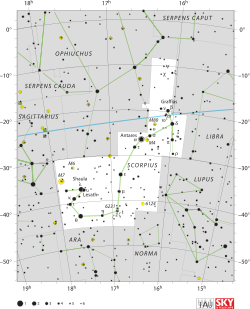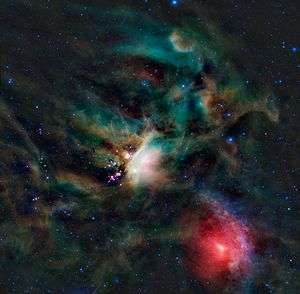Sigma Scorpii

| |
| Observation data Epoch J2000.0 Equinox J2000.0 | |
|---|---|
| Constellation | Scorpius |
| Right ascension | 16h 21m 11.31571s[1] |
| Declination | –25° 35′ 34.0515″[1] |
| Apparent magnitude (V) | +2.88[2] |
| Characteristics | |
| Spectral type | B1 III[3] + B1 V[4] |
| U−B color index | –0.70[2] |
| B−V color index | +0.13[2] |
| Astrometry | |
| Radial velocity (Rv) | –0.4[5] km/s |
| Proper motion (μ) | RA: –10.60[1] mas/yr Dec.: –16.28[1] mas/yr |
| Distance | 568+75 −59 ly (174+23 −18[4] pc) |
| Absolute magnitude (MV) | −4.12±0.34 / −3.32±0.34[4] |
| Orbit[4] | |
| Primary | σ Sco A |
| Companion | σ Sco B |
| Period (P) | 33.010±0.002 days |
| Semi-major axis (a) | 3.62±0.06 mas |
| Eccentricity (e) | 0.3220±0.0012 |
| Inclination (i) | 158.2±2.3° |
| Longitude of the node (Ω) | 104±5° |
| Periastron epoch (T) | 34889.0±1.0 MJD |
| Argument of periastron (ω) (secondary) | 283±5° |
| Details | |
| σ Sco A | |
| Mass | 18.4±5.4,[4] 17.2-18.0[6] M☉ |
| Radius | 12.7±1.8[4] R☉ |
| Luminosity | (2.9±0.8)×104,[4] 95500[6] L☉ |
| Surface gravity (log g) | 3.85[4] cgs |
| Temperature | 26150±1070,[4]27700[6] K |
| Metallicity [Fe/H] | −0.20±0.20[7] dex |
| Rotational velocity (v sin i) | 25[8] km/s |
| Age | 8.0±0.2,[9] 8-10[6] Myr |
| σ Sco B | |
| Mass | 11.9±3.1[4] M☉ |
| Radius | 11[4] R☉ |
| Luminosity | (1.6±0.4)×104[4] L☉ |
| Other designations | |
Sigma Scorpii (σ Sco, σ Scorpii) is a star system in the constellation Scorpius. It has the traditional name Al Niyat, although this name is sometimes also applied to Tau Scorpii, or to the asterism formed by both Sigma and Tau. This system has a combined apparent visual magnitude of +2.88,[2] making it one of the brighter members of the constellation, although greatly outshone by its neighbor Antares. Based upon parallax measurements made during the Hipparcos mission, the distance to Sigma Scorpii is roughly 696 light years (214 parsecs).[1] North et al. (2007) computed a more accurate estimate of 568+75
−59 light years (174+23
−18 parsecs).[4]

The brightest component of the system is a double-lined spectroscopic binary, which means that the pair has not been resolved using a telescope. Instead, their orbit is determined by changes in their combined spectrum caused by the Doppler shift. This indicates that the pair complete an orbit every 33.01 days and have an orbital eccentricity of 0.32.[4]
The primary component of the spectroscopic binary, σ Scorpii A, is an evolved giant star with a stellar classification of B1 III.[3] It has around 18 times the mass of the Sun and 12 times the Sun's radius.[4] This star is radiating about 29000 times the luminosity of the Sun from its outer envelope at an effective temperature of 26150 K.[4] This is a variable star of the Beta Cephei type, causing the apparent magnitude to vary between +2.86 and +2.94 with multiple periods of 0.2468429, 0.239671, and 8.2 days. During each pulsation cycle, the temperature of the star varies by 4000±2000 K.[4]
The other member of the core pair, σ Scorpii B, is a main sequence star with a classification of B1 V.[4] Orbiting this binary at a separation half an arcsecond, or at least 120 Astronomical Units (AU), four times the Sun–Neptune distance, is the magnitude +5.2 σ Scorpii C, which has an orbital period of over a hundred years. Even farther out at 20 arcseconds, or more than 4500 AU, is σ Scorpii D with a magnitude of +8.7. It is classified as a B9 dwarf.
Given its position, youth, and space velocity, the Sigma Scorpii system is a likely member of the Gould Belt,[11] and in particular the Upper Scorpius subgroup of the Scorpius-Centaurus Association (Sco OB2). Recent isochronal age estimates for the Sigma Scorpii system yield ages of 8–10 million years through comparison of the HR diagram positions for the stars to modern evolutionary tracks.[4][6] This agrees well with mean age for the Upper Scorpius group which is approximately 11 million years.[6]
Culture signification
The indigenous Boorong people of northwestern Victoria saw this star (together with τ Sco) as wives of Djuit (Antares).[12]
References
- 1 2 3 4 5 van Leeuwen, F. (November 2007). "Validation of the new Hipparcos reduction". Astronomy and Astrophysics. 474 (2): 653–664. arXiv:0708.1752
 . Bibcode:2007A&A...474..653V. doi:10.1051/0004-6361:20078357.
. Bibcode:2007A&A...474..653V. doi:10.1051/0004-6361:20078357. - 1 2 3 4 Johnson, H. L.; et al. (1966). "UBVRIJKL photometry of the bright stars". Communications of the Lunar and Planetary Laboratory. 4 (99). Bibcode:1966CoLPL...4...99J.
- 1 2 Houk, Nancy (1978), Michigan catalogue of two-dimensional spectral types for the HD stars, 4, Ann Arbor: Dept. of Astronomy, University of Michigan, Bibcode:1988mcts.book.....H
- 1 2 3 4 5 6 7 8 9 10 11 12 13 14 15 16 17 18 19 North, J. R.; et al. (September 2007), "Orbital solution and fundamental parameters of σ Scorpii", Monthly Notices of the Royal Astronomical Society, 380 (3): 1276–1284, arXiv:0707.0897
 , Bibcode:2007MNRAS.380.1276N, doi:10.1111/j.1365-2966.2007.12188.x
, Bibcode:2007MNRAS.380.1276N, doi:10.1111/j.1365-2966.2007.12188.x - ↑ Wilson, R. E. (1953). General Catalogue of Stellar Radial Velocities. Carnegie Institute of Washington D.C. Bibcode:1953GCRV..C......0W.
- 1 2 3 4 5 6 Mark J. Pecaut; Eric E. Mamajek & Eric J. Bubar (February 2012). "A Revised Age for Upper Scorpius and the Star Formation History among the F-type Members of the Scorpius-Centaurus OB Association". Astrophysical Journal. 746 (2): 154. arXiv:1112.1695
 . Bibcode:2012ApJ...746..154P. doi:10.1088/0004-637X/746/2/154.
. Bibcode:2012ApJ...746..154P. doi:10.1088/0004-637X/746/2/154. - ↑ Niemczura, E.; Daszyńska-Daszkiewicz, J. (April 2005), "Metallicities of the β Cephei stars from low-resolution ultraviolet spectra", Astronomy and Astrophysics, 433 (2): 659–669, arXiv:astro-ph/0410440
 , Bibcode:2005A&A...433..659N, doi:10.1051/0004-6361:20040396. Note: value taken from [m/H].
, Bibcode:2005A&A...433..659N, doi:10.1051/0004-6361:20040396. Note: value taken from [m/H]. - ↑ Abt, Helmut A.; Levato, Hugo; Grosso, Monica (July 2002), "Rotational Velocities of B Stars", The Astrophysical Journal, 573 (1): 359–365, Bibcode:2002ApJ...573..359A, doi:10.1086/340590
- ↑ Tetzlaff, N.; Neuhäuser, R.; Hohle, M. M. (January 2011), "A catalogue of young runaway Hipparcos stars within 3 kpc from the Sun", Monthly Notices of the Royal Astronomical Society, 410 (1): 190–200, arXiv:1007.4883
 , Bibcode:2011MNRAS.410..190T, doi:10.1111/j.1365-2966.2010.17434.x
, Bibcode:2011MNRAS.410..190T, doi:10.1111/j.1365-2966.2010.17434.x - ↑ "sig Sco -- Variable Star of beta Cep type", SIMBAD Astronomical Object Database, Centre de Données astronomiques de Strasbourg, retrieved 2012-02-28
- ↑ Bobylev, V. V.; Bajkova, A. T. (September 2007), "Kinematics of the Scorpius-Centaurus OB association", Astronomy Letters, 33 (9): 571–583, arXiv:0708.0943
 , Bibcode:2007AstL...33..571B, doi:10.1134/S1063773707090010
, Bibcode:2007AstL...33..571B, doi:10.1134/S1063773707090010 - ↑ Hamacher, Duane W.; Frew, David J. (2010). "An Aboriginal Australian Record of the Great Eruption of Eta Carinae" (PDF). Journal of Astronomical History & Heritage. 13 (3): 220–34. arXiv:1010.4610
 . Bibcode:2010JAHH...13..220H.
. Bibcode:2010JAHH...13..220H.